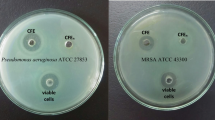Abstract
Caffeine and related xanthines were identified as potent stimulators for the bacterial cellulose production in A. xylinum. These compounds are present in several plants whose infusions are useful as culture-medium supplements for this acetobacterium.
The proposed target for these native purine-like inhibitory substances is the novel diguanyl nucleotide phosphodiesterase(s) that participate(s) in the bacterial cellulogenic complex.
A better understanding of this feature of A. xylinum physiology may facilitate the preparation of bacterial cellulose pellicles, which are applied as a biotechnological tool in the treatment of skin burns and other dermal injuries.
Similar content being viewed by others
References
Brown, A. J. (1886),J. Chem. Soc. Trans. 49, 432–439.
Delmer, D. P. (1983),Adv. Carbohydr. Chem. Biochem. 41, 105–153.
Lin, F. C., Brown, R. M. Jr., Cooper, J. B., and Delmer, D. P. (1985),Science 230, 822–825.
Ross, P., Aloni, Y., Weinhouse, H., Michael, D., Weinberger-Ohana, P., Mayer, R., and Benziman, M. (1986),Carbohydr. Res. 149, 101–117.
Thelen, M. P. and Delmer, D. P. (1986),Plant Physiol. 81, 913–918.
Delmer, D. P. (1987), The biochemistry of cellulose biosynthesis.Tappi J. Nov., 141–143.
Ross, P., Weinhouse, H., Aloni, Y., Michaeli, D., Weinberger-Ohana, P., Mayer, R., Braun, S., de Vroom, E., van der Marel, G. A., van Boom, J. H., and Benziman, M. (1987),Nature 325, 279–281.
de Ley, J., Swings, J., and Gossele, F. (1984), Family VI. Acetobacteracea, Bergey’s Manual of Systematic Bacteriology, vol. II, Krieg, N., and Holt, J. G., eds., Williams & Wilkins, Baltimore, MD, pp. 268–274.
Fontana, J. D., de Souza, A. M., Fontana, C. K., Torriani, I. L., Moreschi, J. C., Gallotti, B. J., de Souza, S. J., Narciso, G. P., Bichara, J. A., and Farah, L. F. (1990),Appl. Biochem. Biotechnol. 24/25, 253–264.
Williams, W. C. and Cannon, R. E. (1989),Appl. Environ. Microbiol. 55(10), 2448–2452.
Rainbow, C. and Mitson, G. W. (1953),J. Gen. Microbiol. 9, 371–375.
Savidge, R. A. and Colvin, J. R. (1985),Can. J. Microbiol. 31, 1019–1025.
Forng, E. R., Anderson, S. M., and Cannon, R. E. (1989),Appl. Environ. Microbiol. 55(5), 1317–1319.
Abadie, S. (1961),Ann. Sci. Nat. Botan. Biol. Vegetale 2, 765–780.
Hestrin, S. and Schramm, M. (1954),Biochem. J. 58, 345–352.
Pitanguy, I., Brentano, J. M. S., Bos, H., Salgado, F., and Mazzarone, F. (1988),Rev. Bras. Cir. 78(1), 67–78.
Castro, O. C., Ribeiro Filho, A. S., Nogueira, V. M. (1988),HFA-Publ. Tec. Cient. (Brasilia)3(3), 209–232.
Pires, M. C., Reis, V. M. S., Gatti, T. R., Pegas, J. R. P., Guerra, J. M. M., and Sarpieri, A. (1989). VI World Congress of Dermatology, Rio de Janeiro.Rev. Bras. Dermatol. (in press).
Gattaz Sobrinho, A. (1989),Rev. Bras. Cir. 79(1), 45–51.
Mayall, R. C., Mayall, A. C. D. G., and Rocha, H. C. (1989), XIX World Congress of the International Society for Cardiovascular Surgery, Toronto.Rev. Bras. Angiol. (in press).
Haigler, C. H., Brown, R. M., Jr., and Benziman, M. (1980),Science 210, 903–906.
Bray, G. A. (1960),Anal. Biochem. 1, 279–285.
Horwitz, W. (1975),Official Methods of Analysis of the AOAC, Washington, XII Ed., p. 678.
Lehninger, A. L. (1975),Biochemistry, 2nd Ed., Worth, New York.
Grasselli, J. G. (1973),Atlas of Spectral Data and Physical Constants of Organic Compounds, CRC, Cleveland, OH, p. B-393.
Michl, H. and Haberler, F. (1954),Monatsh. 85(4), 779–795.
Nair, K. G. (1966), Biochemistry5(1), 150–157.
Corbascio, A. N. (1971),Clin. Pharmac. Ther. 12, 559–561.
Peytavin, J. L. (1986),Biofutur Juin, 37–40.
Cabrai, L. M. (1989), MSc Thesis, Escola Paulista de Medicina, São Paulo, Brasil.
Author information
Authors and Affiliations
Rights and permissions
About this article
Cite this article
Fontana, J.D., Franco, V.C., De Souza, S.J. et al. Nature of plant stimulators in the production ofAcetobacter xylinum (“tea fungus”) biofilm used in skin therapy. Appl Biochem Biotechnol 28, 341–351 (1991). https://doi.org/10.1007/BF02922613
Issue Date:
DOI: https://doi.org/10.1007/BF02922613




